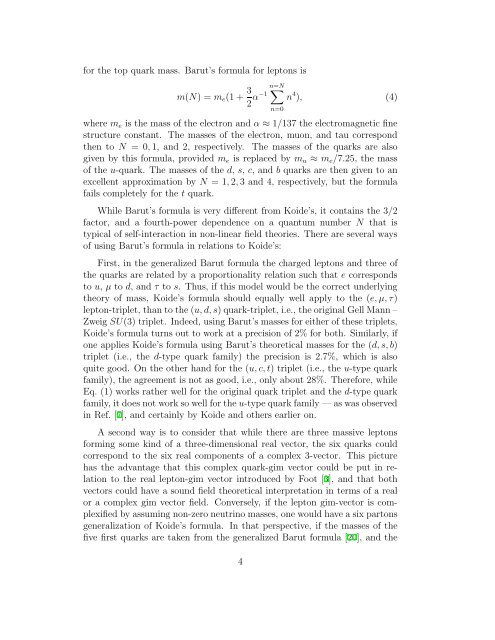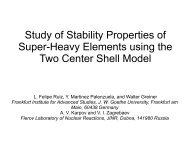The strange formula of Dr. Koide
The strange formula of Dr. Koide
The strange formula of Dr. Koide
You also want an ePaper? Increase the reach of your titles
YUMPU automatically turns print PDFs into web optimized ePapers that Google loves.
for the top quark mass. Barut’s <strong>formula</strong> for leptons is<br />
m(N) = m e (1 + 3 n=N<br />
∑<br />
2 α−1<br />
n=0<br />
n 4 ), (4)<br />
where m e is the mass <strong>of</strong> the electron and α ≈ 1/137 the electromagnetic fine<br />
structure constant. <strong>The</strong> masses <strong>of</strong> the electron, muon, and tau correspond<br />
then to N = 0, 1, and 2, respectively. <strong>The</strong> masses <strong>of</strong> the quarks are also<br />
given by this <strong>formula</strong>, provided m e is replaced by m u ≈ m e /7.25, the mass<br />
<strong>of</strong> the u-quark. <strong>The</strong> masses <strong>of</strong> the d, s, c, and b quarks are then given to an<br />
excellent approximation by N = 1, 2, 3 and 4, respectively, but the <strong>formula</strong><br />
fails completely for the t quark.<br />
While Barut’s <strong>formula</strong> is very different from <strong>Koide</strong>’s, it contains the 3/2<br />
factor, and a fourth-power dependence on a quantum number N that is<br />
typical <strong>of</strong> self-interaction in non-linear field theories. <strong>The</strong>re are several ways<br />
<strong>of</strong> using Barut’s <strong>formula</strong> in relations to <strong>Koide</strong>’s:<br />
First, in the generalized Barut <strong>formula</strong> the charged leptons and three <strong>of</strong><br />
the quarks are related by a proportionality relation such that e corresponds<br />
to u, µ to d, and τ to s. Thus, if this model would be the correct underlying<br />
theory <strong>of</strong> mass, <strong>Koide</strong>’s <strong>formula</strong> should equally well apply to the (e, µ, τ)<br />
lepton-triplet, than to the (u, d, s) quark-triplet, i.e., the original Gell Mann –<br />
Zweig SU(3) triplet. Indeed, using Barut’s masses for either <strong>of</strong> these triplets,<br />
<strong>Koide</strong>’s <strong>formula</strong> turns out to work at a precision <strong>of</strong> 2% for both. Similarly, if<br />
one applies <strong>Koide</strong>’s <strong>formula</strong> using Barut’s theoretical masses for the (d, s, b)<br />
triplet (i.e., the d-type quark family) the precision is 2.7%, which is also<br />
quite good. On the other hand for the (u, c, t) triplet (i.e., the u-type quark<br />
family), the agreement is not as good, i.e., only about 28%. <strong>The</strong>refore, while<br />
Eq. (1) works rather well for the original quark triplet and the d-type quark<br />
family, it does not work so well for the u-type quark family — as was observed<br />
in Ref. [7], and certainly by <strong>Koide</strong> and others earlier on.<br />
A second way is to consider that while there are three massive leptons<br />
forming some kind <strong>of</strong> a three-dimensional real vector, the six quarks could<br />
correspond to the six real components <strong>of</strong> a complex 3-vector. This picture<br />
has the advantage that this complex quark-gim vector could be put in relation<br />
to the real lepton-gim vector introduced by Foot [3], and that both<br />
vectors could have a sound field theoretical interpretation in terms <strong>of</strong> a real<br />
or a complex gim vector field. Conversely, if the lepton gim-vector is complexified<br />
by assuming non-zero neutrino masses, one would have a six partons<br />
generalization <strong>of</strong> <strong>Koide</strong>’s <strong>formula</strong>. In that perspective, if the masses <strong>of</strong> the<br />
five first quarks are taken from the generalized Barut <strong>formula</strong> [20], and the<br />
4



